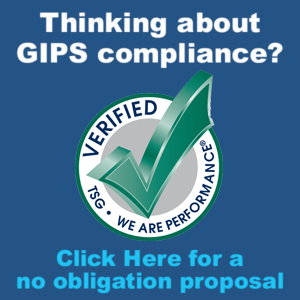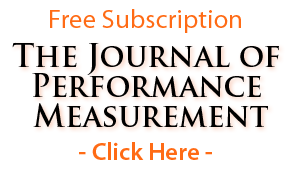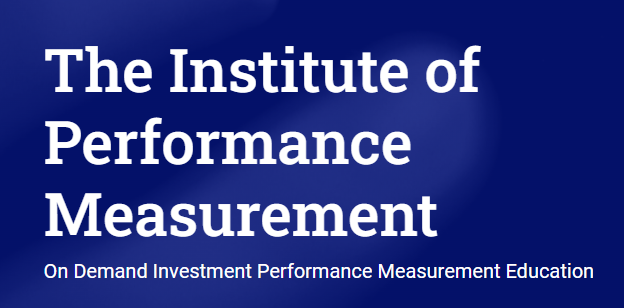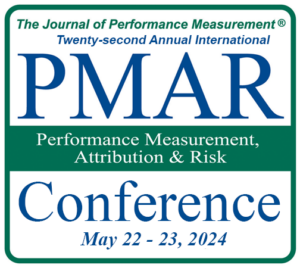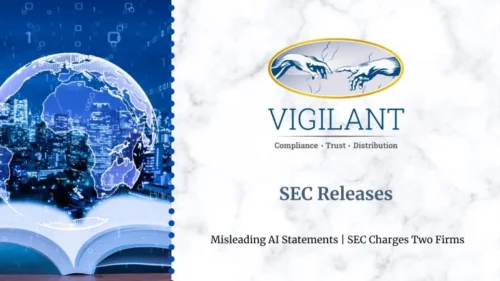Issue Contents:
Navigating Risk-Adjusted Performance: Insights for Financial Professionals
In the world of performance measurement, it is important to understand risk-adjusted performance. This concept, although not new, continues to evolve, offering valuable insights for financial professionals. Let’s delve into the nuances of risk-adjusted performance and its implications for investment evaluation.
Foundations of Risk-Adjusted Performance:
Dating back to the pioneering works of Peter O. Dietz, Jack Treynor, and William Sharpe, the assessment of risk-adjusted performance has been a cornerstone of investment analysis. Dietz proposed a simplistic approach, while Treynor and Sharpe introduced ratio-based measures such as the Treynor ratio and the Sharpe ratio, respectively.
Sharpe Ratio:
- Developed by William Sharpe, it measures the excess return of an investment per unit of total risk (standard deviation).
- Considers the total risk of the portfolio, including both systematic and unsystematic risk.
- Formula: (Portfolio Return – Risk-Free Rate) / Portfolio Standard Deviation
- Higher values indicate better risk-adjusted performance.
Treynor Ratio:
- Created by Jack Treynor, it evaluates the excess return of an investment per unit of systematic risk (beta).
- Focuses specifically on systematic risk, which is the risk associated with market movements.
- Formula: (Portfolio Return – Risk-Free Rate) / Portfolio Beta
- Particularly useful for assessing investments within a diversified portfolio.
- Like the Sharpe Ratio, higher values are desirable, indicating superior risk-adjusted performance, but Treynor specifically emphasizes the relationship between return and systematic risk.
In essence, while both ratios aim to measure risk-adjusted performance, the Sharpe Ratio considers total risk, whereas the Treynor Ratio emphasizes systematic risk. The choice between them depends on the investor’s preference and the specific context of the investment portfolio.
A Shift in Perspective:
While these ratios have long been hailed as benchmarks for evaluating performance relative to risk, recent reflections prompt a reconsideration. Rather than viewing them as “risk-adjusted returns,” they are more accurately described as ratios expressing returns per unit of risk. This distinction underscores the need for a nuanced interpretation of their significance in investment analysis.
Introducing M-Squared:
Amidst the array of performance metrics, M-Squared, or Modigliani-Modigliani, emerges as a compelling contender. Unlike traditional ratios, M-Squared offers a direct measure of risk-adjusted returns, providing a clearer understanding of investment performance. Its intuitive approach resonates with professionals seeking meaningful insights into portfolio management.
M-Squared
- The Modigliani-Modigliani (M-Squared) method is a risk-adjusted return measure that provides a comprehensive assessment of an investment’s performance. Developed by Franco Modigliani and his granddaughter, Leah Modigliani, it adjusts the return of an investment portfolio for its risk level, offering a clearer understanding of its true performance.
- Unlike other risk-adjusted measures like the Sharpe Ratio or Treynor Ratio, which express returns per unit of risk, M-Squared directly adjusts the return for risk, making it easier to interpret. By factoring in the portfolio’s risk, it provides a more accurate reflection of its performance relative to its risk exposure.
- The M-Squared method is particularly valuable for investors seeking a straightforward and intuitive way to evaluate the effectiveness of their investment strategies. Its emphasis on directly adjusting returns for risk sets it apart as a powerful tool for informed decision-making in investment management.
Exploring Jensen’s Alpha:
Jensen’s alpha offers another dimension to risk-adjusted performance, focusing on excess returns adjusted for risk. Jensen’s value lies in its consideration of risk factors beyond traditional measures like beta, offering a more comprehensive assessment of investment performance.
Jensen’s Alpha
- Jensen’s Alpha, developed by Michael Jensen, is a risk-adjusted performance measure used to assess an investment’s performance relative to a benchmark.
- Calculates the excess return of an investment portfolio above what would be expected based on its beta (systematic risk) and the market risk premium.
- Jensen’s Alpha helps investors determine whether a portfolio manager has added value beyond what would be expected given the level of risk taken.
- Positive alpha indicates that the portfolio has outperformed the benchmark, while negative alpha suggests underperformance.
- Jensen’s Alpha is a valuable tool for evaluating the skill of portfolio managers and identifying instances of alpha generation.
Challenges and Opportunities:
While risk-adjusted returns should undoubtedly be integral to performance evaluation, discrepancies in interpretation persist. Clarifying the distinction between risk measures, reward-to-risk ratios, and risk-adjusted returns is essential for informed decision-making in financial management.
Looking Ahead:
As financial professionals, our ongoing commitment to understanding and refining performance measurement methodologies is paramount. By embracing emerging metrics and refining our approach to risk assessment, we can navigate the complexities of investment analysis with confidence and precision.
Conclusion:
In our quest to unlock the true essence of risk-adjusted performance, let us embark on a journey of exploration and refinement. By harnessing the insights gleaned from diverse metrics and methodologies, we can empower ourselves to make informed decisions that drive success in the dynamic landscape of finance.
Stay tuned for more insights and updates on performance measurement in our future newsletters.
For more details, please review, “Thoughts and Clarifications on Risk-Adjusted Performance,” by David D. Spaulding, DPS, CIPM, TSG, Inc.
Have an opinion? Please share it with Patrick Fowler.
Quote of the Month
“Stop asking people for directions to places they’ve never been.”
– Glennon Doyle
GIPS® Tips
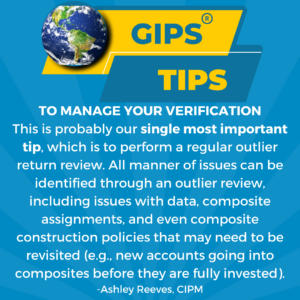
Experience White Glove GIPS® Standards Verification with TSG
Are you tired of being treated like just another number by your GIPS verifier? At TSG, we prioritize your satisfaction and success above all else.
Partnering with us means gaining access to a team of seasoned GIPS specialists dedicated to delivering unparalleled service and exceptional value. Whether you’re seeking a new verifier, preparing for your initial verification, or just starting to explore GIPS compliance, TSG is the best choice.
Why Choose TSG?
Unmatched Expertise: Our experienced team brings unmatched proficiency in GIPS standards, ensuring thorough and efficient (not “never-ending”) verifications.
Personalized Support: We understand that the journey towards GIPS compliance is complex. That’s why we offer ongoing support and guidance as needed, as well as access to a suite of exclusive proprietary tools, designed to make compliance and verification as easy as possible for you and your firm.
Actionable Insights: When you choose TSG, you will work with ONLY highly experienced senior-level GIPS and performance specialists. Their expertise translates into actionable advice, helping you navigate the complexities of the Standards in the most ideal way for your firm.
Hassle-Free Experience: At TSG, we guarantee your satisfaction and we do not lock our clients into long-term contracts.
Ready to Experience the TSG Difference?
Take the first step towards a better GIPS standards verification. Schedule a call or request a no-obligation proposal today at GIPSStandardsVerifications.com.
The Journal of Performance Measurement®
This month’s article brief spotlights, “A Decision-based Approach to Risk-Adjusted Performance Attribution” by Arno E. Weber of Ortec Finance, which was published in volume 28, issue #2 of The Journal of Performance Measurement. You can access this article by subscribing (for free) to The Journal (link below). To confirm your email address, click the graphic below. If you’re a subscriber but haven’t received a link the the current issue, please reach out to Doug Spaulding at DougSpaulding@TSGperformance.com.
Investment decisions change the risk profile of a portfolio. This is usually on purpose: a manager taking an active investment decision foresees that exposing the portfolio to a different level of risk will eventually pay off, given his outlook on the market. It is therefore important to evaluate the performance of a portfolio not only by measuring the return contribution of each decision, but also by making explicit how the risk decision impacted this contribution. In this article, we propose an attribution method which combines the concepts of Brinson-Fachler attribution and risk-adjusted returns. For each investment decision and the corresponding attribution effect, we identify a component due to risk-adjusted outperformance and a second component due to the incremental risk resulting from the active investment decision. We demonstrate the importance of applying this decomposition method to the levels on which the investment decisions take place. Finally, we provide guidance on how to apply this generic method to various investment strategies and the corresponding attribution methods.
ATTN: TSG Verification Clients
For GIPS clients, please remember to register your claim of compliance with CFA Institute by June 30, with respect to your status on December 31, 2023. The date is fast approaching.
Reminder for TSG GIPS clients: As a client, you are entitled to one complimentary pass to PMAR 2024. Contact Andrew Tona to reserve your space.
TSG Milestones
Join us for a 5K on Day 2 of the PMAR Conference!
The Sandra Hahn-Colbert 5K Run/Walk will take place on May 23rd at 7:15 AM. The route will take us through downtown New Brunswick and into Johnson Park along the northern banks of the Raritan River. In addition to the 5K, we’ll be offering a 1-1.5 mile walk. All participants will receive a finisher coin. If you have any questions, or you’d like to register early, please contact Doug Spaulding at DougSpaulding@TSGperformance.com.
For more information on the PMAR Conference, click here, https://tsgperformance.com/events/pmar/.
PUZZLE TIME

Here’s this month’s puzzle; Solution in the next issue!
Find the next two numbers in the series …
19 16 1 21 12 4 9
Last month’s puzzle and solution.
Last month’s puzzle caused a little confusion and had us revisiting order of operations.
- Solve this equation:
24/6*(4-2)
The Solution: 8. Parentheses are first but then you go left to right. Multiplication next to parentheses does not take precedence over the division that’s on the left.
Correct Answer Respondents:
- Michael Beck
- John D. Simpson
- Michael Margulis (submitted puzzle)
Please submit your puzzle solution or puzzle ideas to Patrick Fowler.
Institute / Training
Access All of TSG’s Online Performance, Attribution, Risk, and Python Content
With One Multi-Pass
Book Review
The Holy Grail of Investing, by Tony Robbins
Review by David D. Spaulding, DPS, CIPM
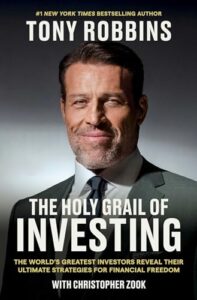
I’ll begin this review by making it clear that I am a huge fan of Tony Robbins. I was given his 30-day tape (yes, cassette tapes) Personal Power for Christmas, 1989. I had never heard of Tony, but had been a listener of tapes for some time. I began his program on Monday, January 1, 1990, which was fortuitous, as it allowed me to align his day numbers with the days of the month.
Within two weeks, I realized I should start my own business. Within a few months, I did just that. Please understand that before that time, I had zero interest in doing this.
Since that introduction to Tony, I’ve attended a few of his programs and read at least two other books.
I was attracted to his latest book based on a piece that appeared in Investment News; I commented on it in a recent LinkedIn post.1
My initial criticism was his hype about private equity returns relative to public equity. I intend to produce a longer piece dealing specifically with this topic, but “bottom line,” given that they are different in so many ways, is there really a fair way to compare them?
I had intended to purchase the book, and coincidentally was in a local Barnes & Noble with my fiancé, where I spied the book on display. I immediately purchased it, and took it with me on a recent trip to Saudi Arabia. I read it within just a few days.
I found much to criticize about the book, though there were some good and interesting points, too.
He begins the book criticizing “the reckless behavior and greed of a relative few,” who he credits with the 2008 financial crisis. Anyone who’s familiar with that crisis knows there were not just a few who can be included in the group [not so relatively few] who contributed to that crisis. Goldman Sachs seemed to get a lot of criticism, beginning with Michael Lewis’ The Big Short, which I suspect was read by folks at the U.S. Securities & Exchange Commission (SEC), because they seemed to go after Goldman with a vengeance. I felt Lewis’ evaluation of what occurred to be unfair and incomplete. What were U.S. banks to do when Congress pressured them to lower normal limits, so more Americans could “live the American dream” [of home ownership]. Can Goldman be blamed for the top scores rating agencies gave to mortgage backed securities, that were filled with sub-prime (and therefore, more risky) mortgages? I could go on and on, but that’s not the point of this review. Suffice it to say, Robbins took a too common approach laying the entire blame on just a few wrong people (who I suspect he thinks of as Wall Street folks).
If you read the book, get ready to learn of all the “good friends” Tony has. I guess name-dropping is something many of us will do, but with Tony, it began to get tiresome. He mentions Ray Dalio’s name way too often, each time making it clear that he’s his good friend.
What’s the “holy grail”? He got the idea from Dalio, who said that it’s “a portfolio of eight to twelve uncorrelated (or non-correlated) investments which, together, will dramatically reduce risk without sacrificing returns.” <emphasis in original> There’s nothing new here; this has been taught for more than 50 years.
Much of the book deals with various investment approaches, from private equity to sports teams; many, if not most, of these asset classes are not available to most investors. And so, to sing the praises of folks who invest in sports teams, and who see their investments increase at high rates, might be interesting, but not much more than that.
Robbins takes on the unenviable task of justifying investing in fossil fuel, and gets support for this from multiple investors. While Tony, like most people, is concerned about the environment, he recognizes that it will be a rather long time before we can avoid using fossil fuels for much of our energy needs. He also sings the praises of nuclear, which the United States has [in my view] sadly not capitalized on. He also points out the huge impact electric cars are having on the environment, including their need for rare metals, many of which are controlled by Russia and China.
As with the Investment News piece, I think some of what Robbins touts is misleading. For example, he compares private credit with public bonds, explaining why they get much higher yields (citing, for example, that as interest rates increase, prices drop). But he’s not doing an “apples-to-apples” comparison. As rates rise, we can often buy bonds with higher rates; yes, if we purchased them years ago, then their value has likely dropped, but his analysis is, in a word, incomplete.
Robbins isn’t shy about letting the reader know he has an ulterior motive for the book: he is apparently investing in a general partnership, which is apparently looking to attract more investors. Multiple times he points the reader to a site to get “more information.”
He references the too often Mark Twain statement that “history doesn’t repeat itself, but it rhymes.” <emphasis in original> Okay, so what does he mean by that and how does it fit into what he wrote? I invite you to figure that out, because I couldn’t. I guess sometimes you want to include a quote you like, even if it doesn’t fit.
Did I like the book? Not particularly, as I felt it was from someone who perhaps “knows enough to be dangerous,” who failed too often to provide objective and complete analysis, and who appears to have had some reasons other than to educate for the book. Did I find it interesting? At times. I’m not sure I learned very much, but there were still some interesting parts. Would I recommend it? No.
1 https://www.linkedin.com/feed/update/urn:li:activity:7164408835212824576/
2 As a metaphor, the lesson to be learned from these ratings is that if you put enough garbage together, you can end up with sweet smelling perfume.
Navigating Risk-Adjusted Performance: Insights for Financial Professionals
In the world of performance measurement, it is important to understand risk-adjusted performance. This concept, although not new, continues to evolve, offering valuable insights for financial professionals. Let’s delve into the nuances of risk-adjusted performance and its implications for investment evaluation.
Foundations of Risk-Adjusted Performance:
Dating back to the pioneering works of Peter O. Dietz, Jack Treynor, and William Sharpe, the assessment of risk-adjusted performance has been a cornerstone of investment analysis. Dietz proposed a simplistic approach, while Treynor and Sharpe introduced ratio-based measures such as the Treynor ratio and the Sharpe ratio, respectively.
Sharpe Ratio:
- Developed by William Sharpe, it measures the excess return of an investment per unit of total risk (standard deviation).
- Considers the total risk of the portfolio, including both systematic and unsystematic risk.
- Formula: (Portfolio Return – Risk-Free Rate) / Portfolio Standard Deviation
- Higher values indicate better risk-adjusted performance.
Treynor Ratio:
- Created by Jack Treynor, it evaluates the excess return of an investment per unit of systematic risk (beta).
- Focuses specifically on systematic risk, which is the risk associated with market movements.
- Formula: (Portfolio Return – Risk-Free Rate) / Portfolio Beta
- Particularly useful for assessing investments within a diversified portfolio.
- Like the Sharpe Ratio, higher values are desirable, indicating superior risk-adjusted performance, but Treynor specifically emphasizes the relationship between return and systematic risk.
In essence, while both ratios aim to measure risk-adjusted performance, the Sharpe Ratio considers total risk, whereas the Treynor Ratio emphasizes systematic risk. The choice between them depends on the investor’s preference and the specific context of the investment portfolio.
A Shift in Perspective:
While these ratios have long been hailed as benchmarks for evaluating performance relative to risk, recent reflections prompt a reconsideration. Rather than viewing them as “risk-adjusted returns,” they are more accurately described as ratios expressing returns per unit of risk. This distinction underscores the need for a nuanced interpretation of their significance in investment analysis.
Introducing M-Squared:
Amidst the array of performance metrics, M-Squared, or Modigliani-Modigliani, emerges as a compelling contender. Unlike traditional ratios, M-Squared offers a direct measure of risk-adjusted returns, providing a clearer understanding of investment performance. Its intuitive approach resonates with professionals seeking meaningful insights into portfolio management.
M-Squared
- The Modigliani-Modigliani (M-Squared) method is a risk-adjusted return measure that provides a comprehensive assessment of an investment’s performance. Developed by Franco Modigliani and his granddaughter, Leah Modigliani, it adjusts the return of an investment portfolio for its risk level, offering a clearer understanding of its true performance.
- Unlike other risk-adjusted measures like the Sharpe Ratio or Treynor Ratio, which express returns per unit of risk, M-Squared directly adjusts the return for risk, making it easier to interpret. By factoring in the portfolio’s risk, it provides a more accurate reflection of its performance relative to its risk exposure.
- The M-Squared method is particularly valuable for investors seeking a straightforward and intuitive way to evaluate the effectiveness of their investment strategies. Its emphasis on directly adjusting returns for risk sets it apart as a powerful tool for informed decision-making in investment management.
Exploring Jensen’s Alpha:
Jensen’s alpha offers another dimension to risk-adjusted performance, focusing on excess returns adjusted for risk. Jensen’s value lies in its consideration of risk factors beyond traditional measures like beta, offering a more comprehensive assessment of investment performance.
Jensen’s Alpha
- Jensen’s Alpha, developed by Michael Jensen, is a risk-adjusted performance measure used to assess an investment’s performance relative to a benchmark.
- Calculates the excess return of an investment portfolio above what would be expected based on its beta (systematic risk) and the market risk premium.
- Jensen’s Alpha helps investors determine whether a portfolio manager has added value beyond what would be expected given the level of risk taken.
- Positive alpha indicates that the portfolio has outperformed the benchmark, while negative alpha suggests underperformance.
- Jensen’s Alpha is a valuable tool for evaluating the skill of portfolio managers and identifying instances of alpha generation.
Challenges and Opportunities:
While risk-adjusted returns should undoubtedly be integral to performance evaluation, discrepancies in interpretation persist. Clarifying the distinction between risk measures, reward-to-risk ratios, and risk-adjusted returns is essential for informed decision-making in financial management.
Looking Ahead:
As financial professionals, our ongoing commitment to understanding and refining performance measurement methodologies is paramount. By embracing emerging metrics and refining our approach to risk assessment, we can navigate the complexities of investment analysis with confidence and precision.
Conclusion:
In our quest to unlock the true essence of risk-adjusted performance, let us embark on a journey of exploration and refinement. By harnessing the insights gleaned from diverse metrics and methodologies, we can empower ourselves to make informed decisions that drive success in the dynamic landscape of finance.
Stay tuned for more insights and updates on performance measurement in our future newsletters.
For more details, please review, “Thoughts and Clarifications on Risk-Adjusted Performance,” by David D. Spaulding, DPS, CIPM, TSG, Inc.
Have an opinion? Please share it with Patrick Fowler.
Industry Dates and Conferences
2024 EVENTS CALENDAR
- May 21 – Women in Performance Measurement Meeting – New Brunswick, NJ
- May 22-23 – Performance Measurement, Attribution, and Risk Conference (PMAR) – New Brunswick, NJ
- June 12 – Spring Meeting of the Asset Owner Roundtable (AORT) – Las Vegas, NV
- June 13-14 – Spring North American Meeting of the Performance Measurement Forum – Las Vegas, NV
- June 27-28 – Spring EMEA Meeting of the Performance Measurement Forum – Athens, Greece
- November 7-8 – Autumn EMEA Meeting of the Performance Measurement Forum – Barcelona, Spain
- November 20 – Fall Meeting of the Asset Owner Roundtable (AORT) – Charleston, SC
- November 21-22 – Fall North American Meeting of the Performance Measurement Forum – Charleston, SC
For information on the 2024 events, please contact
Patrick Fowler at 732-873-5700.
- Artificial Intelligence and Risk: Should We Be Concerned?
- What’s Missing from Your Equity Attribution Report?
- ESG: Risk, Compliance, and Regulatory Reporting – Why Having the Right Data and Tools is Essential
- How are the New SEC Guidelines Being Practically Implemented and Applied?
- What to Know About the New GIPS® Guidance for OCIOs
- Essential Skillsets of the Performance Professional
- Methods and Styles of Reporting
- Benchmark Misfit
- Paths to a “Rich” Life
- How to Calculate Returns on Options, Futures, and Swaps
- The Reports of After-Tax’s Death Have Been Greatly Exaggerated: Use Cases and Implementation
Question 3: Do you agree with differentiating liability-focused composites from total return objective composites in the Required OCIO Composite structure?
We believe this composite structure should be recommended rather than required. But we do agree that differentiating liability-focused composites from total return objective composites is a reasonable approach.
One comment we do have relates to the firm’s ability to 1) determine how an asset is classified by strategy and 2) change their classification of assets on a prospective basis. If comparability is the justification for requiring a specific composite structure, what does this do to comparability?
That’s a Good Question
Is a platform an “advertisement”?
Question from reader:
For clients using carveouts (extracted performance) in a non-GIPS verification to get on a platform (SMArtX, Envestnet, Morningstar, etc.), is it their (the client’s) responsibility to ensure only sophisticated investors see their performance, or is the assumption that their prospect is the platform, and what the platform does with the performance is the responsibility of the platform, not our client?
TSG’s response:
This raises a fundamental question: is a platform an “advertisement”?
I would say “no.”
The marketing rule deals with advertisements.
If the firm created an ad that went onto the site, that would be different; if they are giving the site numbers that the site then makes available, I don’t think it’s an advertisement.
From page 195 of the Marketing Rule:
The final rule prohibits an adviser from presenting extracted performance in an advertisement unless the advertisement provides, or offers to provide promptly, the performance results of the total portfolio from which the performance was extracted.653 “Extracted performance” means “the performance results of a subset of investments extracted from a portfolio.”
Again, I would not consider the platform to be an “advertisement.”
They are providing numbers that someone else will showcase.
What the platform does with the performance is the responsibility of the platform, not our client?
I would say “yes.” Not client’s responsibility.
Please submit your questions to Patrick Fowler.
Compliance Corner
Deceptive AI Claims Lead to SEC Charges Against Two Firms
In a recent development, the Securities and Exchange Commission (SEC) revealed charges against two investment advisers on March 18th. These firms were accused of disseminating inaccurate and deceptive information regarding their utilization of Artificial Intelligence (AI).
Given the prevalent discussions surrounding AI across industries and society, it’s imperative for firms to provide precise descriptions of their AI applications in advertisements and filings to prevent investor misguidance. The consequences for the accused firms amounted to penalties totaling $400,000.
Visit our friends at Vigilant for the full article.
Potpourri

Article Submissions
The Journal of Performance Measurement® is currently accepting article submissions
The Journal of Performance Measurement is currently accepting article submissions on topics including performance measurement, risk, ESG, AI, and attribution. We are particularly interested in articles that cover practical performance issues and solutions that performance professionals face every day. All articles are subject to a double-blind review process before being approved for publication. White papers will also be considered. For more information and to receive our manuscript guidelines, please contact Douglas Spaulding at DougSpaulding@TSGperformance.com.
Submission deadlines
Spring Issue: April 22, 2024
Summer Issue: July 12, 2024
Survey Results from February’s Newsletter:
- The GIPS standards have now had four versions (1999, 2005, 2010, 2020). Do you feel they’ve gotten harder or easier to comply with, or has it stayed pretty much the same?
- They’ve gotten harder to comply with – 25%
- They’re easier to comply with – 25%
- They’re about the same – 50%
- Do you feel the Standards have grown in importance globally over the past 25 years?
- Yes – 100%
- No – 0%
- Comments:
- Slow progress for asset owners, even after the 2020 version
- I think that they grew more important rather quickly in the first few years, but importance essentially plateaued after that.
TSG is conducting another brief survey on Artificial Intelligence / Machine Learning. Please take a moment to respond to it.
GIPS® is a registered trademark owned by CFA Institute. CFA Institute does not endorse or promote this organization, nor does it warrant the accuracy or quality of the content contained herein.


